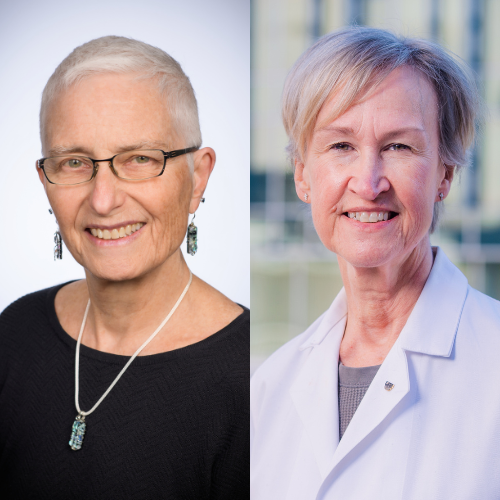 Christine A. Curcio, Ph.D. and Cynthia Owsley, Ph.D., MSPHAge-related macular degeneration (AMD) threatens detailed vision in millions of older persons globally. While current treatments aim to prevent or stabilize advanced disease, the quest for early intervention remains paramount. Christine A. Curcio, Ph.D., and Cynthia Owsley, Ph.D., MSPH, esteemed researchers at the University of Alabama at Birmingham (UAB), are at the forefront of groundbreaking research with the NIH-funded Alabama Study on Early Age-Related Macular Degeneration 2 (ALSTAR2).
Christine A. Curcio, Ph.D. and Cynthia Owsley, Ph.D., MSPHAge-related macular degeneration (AMD) threatens detailed vision in millions of older persons globally. While current treatments aim to prevent or stabilize advanced disease, the quest for early intervention remains paramount. Christine A. Curcio, Ph.D., and Cynthia Owsley, Ph.D., MSPH, esteemed researchers at the University of Alabama at Birmingham (UAB), are at the forefront of groundbreaking research with the NIH-funded Alabama Study on Early Age-Related Macular Degeneration 2 (ALSTAR2).
Curcio, the White-McKee Endowed Professor in Ophthalmology and Director of the AMD Histopathology Lab at UAB, and Owsley, the Nathan E. Miles Chair of Ophthalmology and Director of the Clinical Research Unit for the UAB Department of Ophthalmology and Visual Sciences, have dedicated their expertise to understanding and combating AMD at its earliest stages. Their collaborative efforts have led to significant advancements in the field, offering hope for the early detection and prevention of this vision-degrading condition.
The key focus of their research lies in developing a vision test known as rod-mediated dark adaptation (RMDA). This innovative test assesses the speed at which nerve cells called rod photoreceptors recover sensitivity after exposure to a flash of bright light. In aging and AMD, rod photoreceptors recover slowly, providing valuable insights into onset and early progression of the disease.
The biological basis of RMDA lies in the delivery of molecules related to vitamin A from the circulation. These molecules traverse tissue layers directly impacted by AMD pathology. Over three decades of clinical and laboratory research, Curcio and Owsley have demonstrated that dim light vision deteriorates at the periphery of the macula lutea, the formal name for a yellow spot visible in the back of the eye. This region is particularly vulnerable to AMD, marked by the presence of soft drusen, characteristic deposits associated with the disease, that form under the macula lutea.
 One crucial factor contributing to the risk of developing AMD is the failure of the choriocapillaris, a specialized microvasculature that supports cells of the outer retina. The correlation between the deterioration of dim light vision and the presence of soft drusen underscores the importance of understanding these early indicators for effective intervention.
One crucial factor contributing to the risk of developing AMD is the failure of the choriocapillaris, a specialized microvasculature that supports cells of the outer retina. The correlation between the deterioration of dim light vision and the presence of soft drusen underscores the importance of understanding these early indicators for effective intervention.
The significance of RMDA lies in its ability to detect abnormal vision in the preliminary stages of AMD, even preceding intermediate stages. By assessing the speed of recovery in rod photoreceptors, researchers can identify individuals at higher risk of developing advanced AMD. This breakthrough in early detection opens avenues for interventions that can potentially slow or prevent the progression of the disease.
Looking ahead, Curcio and Owsley plan to delve deeper into the everyday experiences of patients with slowed RMDA. They aim to shorten the time needed for RMDA testing and explore its potential as a benchmark for other diagnostic tests, such as retinal imaging. These advancements will not only enhance the efficiency of clinical trials but also streamline diagnostic procedures in clinical practice.
In a recent announcement, Curcio expressed her gratitude to all and disclosed her retirement from UAB as of March 1, 2024. She plans to return as an emeritus professor, pending the collaborative approval of the Board of Trustees. Despite this transition, Curcio remains committed to advancing her work on the ALSTAR2 project. Her dedication underscores the enduring mission to beat AMD and improve the lives of individuals affected by this prevalent and debilitating eye condition.
The collaborative efforts of Curcio and Owsley stand as a beacon of hope in the realm of AMD research. Their pioneering work on RMDA not only offers a revolutionary approach to early detection but also lays the foundation for future interventions and preventions that could transform the lives of patients with AMD. As we anticipate the next phase of their research, the impact of their contributions to ophthalmology and vision science is poised to endure, promising a brighter future for those at risk of age-related macular degeneration.